EN 50341
The uplift resistance Rt combines the weight of the soil overburden and footing + friction along the footing walls and soil block above the footing. The soil properties are determined according to the overburdentype from the "Foundation" frame.If the chosen type is "input shape and soil" or "from geological profile" the angle of internal friction φ and cohesion c are taken from the assigned soils. In the case of "input unit weigh" the "Bearing cap." frame in the "Verification on uplift" dialog window allows us to input the angle of internal friction of overburden φ and cohesion of overburden c.
 Dialog window "Verification on uplift" - EN 50341
Dialog window "Verification on uplift" - EN 50341
The uplift resistance follows from:
![]()
where: | Rs | - | bearing capacity along the foundation |
Rb | - | bearing capacity along the soil block | |
Gf | - | weight of foundation | |
Gb | - | weight of overburden |
The bearing capacity along the foundation is calculated from:
![]()
![]()
where: | p | - | footing perimeter |
c | - | cohesion of the soil | |
Kr | - | coefficient of the earth pressure at rest | |
γ | - | weight of the soil | |
d | - | depth of the footing bottom | |
t | - | footing thickness | |
φ | - | angle of internal friction of the soil |
The bearing capacity along the soil block is calculated from:
![]()
![]()
where: | p | - | footing perimeter |
d | - | depth of the footing bottom | |
t | - | footing thickness | |
Ka | - | coefficient of active earth pressure | |
γ | - | weight of soil | |
φ | - | angle of internal friction of the soil |
 Verification on uplift - EN 50431
Verification on uplift - EN 50431